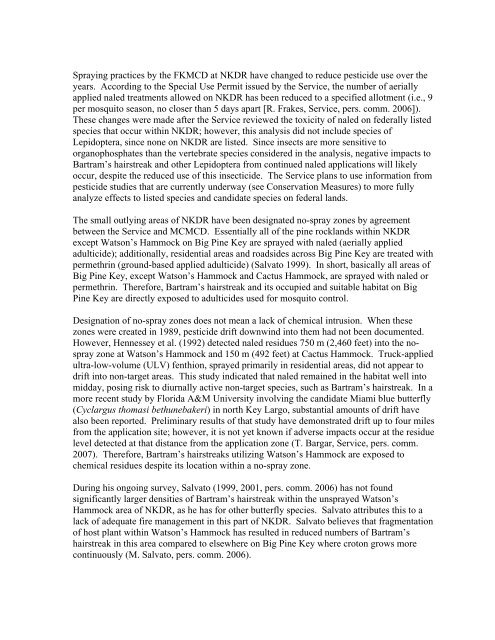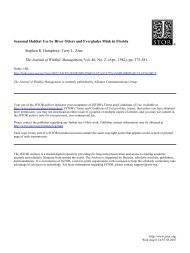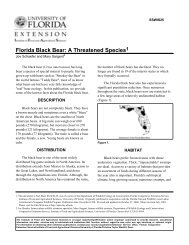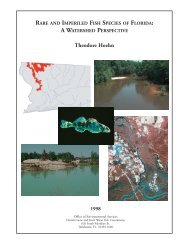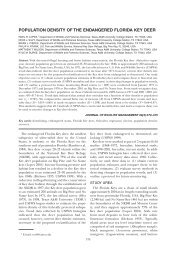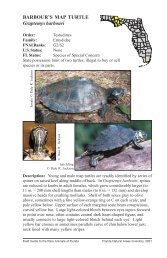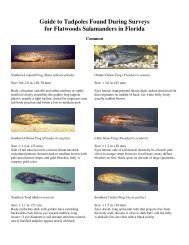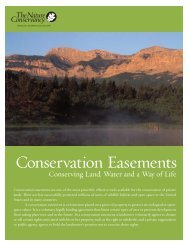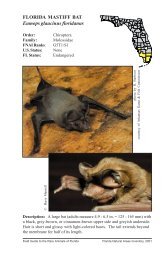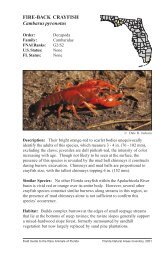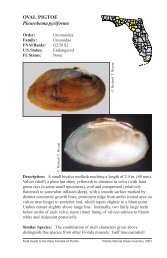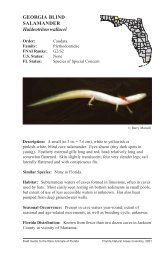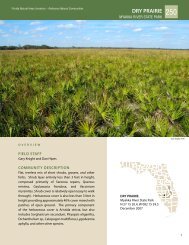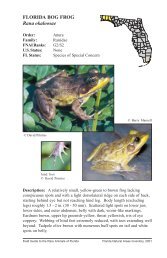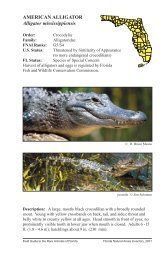Bartram's hairstreak butterfly - Florida Wildlife Conservation Guide
Bartram's hairstreak butterfly - Florida Wildlife Conservation Guide
Bartram's hairstreak butterfly - Florida Wildlife Conservation Guide
Create successful ePaper yourself
Turn your PDF publications into a flip-book with our unique Google optimized e-Paper software.
Spraying practices by the FKMCD at NKDR have changed to reduce pesticide use over the<br />
years. According to the Special Use Permit issued by the Service, the number of aerially<br />
applied naled treatments allowed on NKDR has been reduced to a specified allotment (i.e., 9<br />
per mosquito season, no closer than 5 days apart [R. Frakes, Service, pers. comm. 2006]).<br />
These changes were made after the Service reviewed the toxicity of naled on federally listed<br />
species that occur within NKDR; however, this analysis did not include species of<br />
Lepidoptera, since none on NKDR are listed. Since insects are more sensitive to<br />
organophosphates than the vertebrate species considered in the analysis, negative impacts to<br />
Bartram’s <strong>hairstreak</strong> and other Lepidoptera from continued naled applications will likely<br />
occur, despite the reduced use of this insecticide. The Service plans to use information from<br />
pesticide studies that are currently underway (see <strong>Conservation</strong> Measures) to more fully<br />
analyze effects to listed species and candidate species on federal lands.<br />
The small outlying areas of NKDR have been designated no-spray zones by agreement<br />
between the Service and MCMCD. Essentially all of the pine rocklands within NKDR<br />
except Watson’s Hammock on Big Pine Key are sprayed with naled (aerially applied<br />
adulticide); additionally, residential areas and roadsides across Big Pine Key are treated with<br />
permethrin (ground-based applied adulticide) (Salvato 1999). In short, basically all areas of<br />
Big Pine Key, except Watson’s Hammock and Cactus Hammock, are sprayed with naled or<br />
permethrin. Therefore, Bartram’s <strong>hairstreak</strong> and its occupied and suitable habitat on Big<br />
Pine Key are directly exposed to adulticides used for mosquito control.<br />
Designation of no-spray zones does not mean a lack of chemical intrusion. When these<br />
zones were created in 1989, pesticide drift downwind into them had not been documented.<br />
However, Hennessey et al. (1992) detected naled residues 750 m (2,460 feet) into the nospray<br />
zone at Watson’s Hammock and 150 m (492 feet) at Cactus Hammock. Truck-applied<br />
ultra-low-volume (ULV) fenthion, sprayed primarily in residential areas, did not appear to<br />
drift into non-target areas. This study indicated that naled remained in the habitat well into<br />
midday, posing risk to diurnally active non-target species, such as Bartram’s <strong>hairstreak</strong>. In a<br />
more recent study by <strong>Florida</strong> A&M University involving the candidate Miami blue <strong>butterfly</strong><br />
(Cyclargus thomasi bethunebakeri) in north Key Largo, substantial amounts of drift have<br />
also been reported. Preliminary results of that study have demonstrated drift up to four miles<br />
from the application site; however, it is not yet known if adverse impacts occur at the residue<br />
level detected at that distance from the application zone (T. Bargar, Service, pers. comm.<br />
2007). Therefore, Bartram’s <strong>hairstreak</strong>s utilizing Watson’s Hammock are exposed to<br />
chemical residues despite its location within a no-spray zone.<br />
During his ongoing survey, Salvato (1999, 2001, pers. comm. 2006) has not found<br />
significantly larger densities of Bartram’s <strong>hairstreak</strong> within the unsprayed Watson’s<br />
Hammock area of NKDR, as he has for other <strong>butterfly</strong> species. Salvato attributes this to a<br />
lack of adequate fire management in this part of NKDR. Salvato believes that fragmentation<br />
of host plant within Watson’s Hammock has resulted in reduced numbers of Bartram’s<br />
<strong>hairstreak</strong> in this area compared to elsewhere on Big Pine Key where croton grows more<br />
continuously (M. Salvato, pers. comm. 2006).


